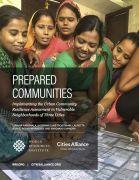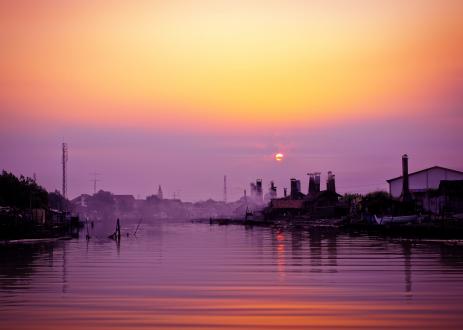Prepared Communities
Implementing the Urban Community Resilience Assessment in Vulnerable Neighborhoods of Three Cities

Synopsis
Climate change affects poor and marginalized communities first and hardest. Particularly in cities, a lack of access to basic services, a long history of unsustainable urban development, and political exclusion render the urban poor one of the most vulnerable groups to climate induced natural hazards and disasters. Yet strategies focused on reducing these people’s vulnerability to climate change often overlook crucial differences in their needs and situations.
In response, WRI has developed the Urban Community Resilience Assessment (UCRA), a tool for city planners to measure differentiated needs for climate resilience. Accurate and detailed risk data at the city- and neighborhood-levels, is key to ensuring cities will develop appropriate resilience responses. Measuring how communities and individuals have responded to potential climate risks can help identify needs for resilience and inform effective urban resilience planning. UCRA was piloted in three low-income and vulnerable communities: Rio de Janeiro, Brazil, Surat, India, and Semarang, Indonesia. This report describes the pilot project results, insights and the potential for UCRA to build more climate-resilient cities.
Key Findings
Cities can benefit from the UCRA process in several ways. The process helps officials connect resilience actions and policies to vulnerable communities, promotes a culture of inclusive planning, involves multiple stakeholders and participatory activities, and provides cities with a baseline of detailed data at the local level. The city resilience strategy, participatory visioning workshops, and community-level consultations represent a platform for mainstreaming resilience thinking across communities in a city.
Pilot implementation of the UCRA revealed three main limitations. First, a lack of political will and leadership to drive the UCRA process lengthens the implementation period and reduces effectiveness. Second, the UCRA methodology is costly and time-intensive. Third, incongruencies in data, information, and language across the city, neighborhood, and individual levels make it difficult to build consensus among city officials and community members.
The UCRA has the potential to promote peer-to-peer learning between cities. Developing an online community of practice could help promote pro-poor urban climate resilience planning by allowing cities to exchange insights, visually display and share results, and help them overcome barriers to implementation more rapidly.
Executive Summary
Urban resilience is receiving more global attention than ever before. The SDGs and the Paris Agreement make clear commitments to prioritize the lives and well-being of vulnerable communities living in cities. The Urban Community Resilience Assessment tool is well positioned to help cities leverage this international momentum to strengthen social resilience while achieving resilience goals.
This report describes the UCRA and its application in poor communities of Rio de Janeiro, Brazil; Surat, India; and Semarang, Indonesia —three coastal cities that are at increased risk of flooding, landslides, land subsidence, and heat stress. It describes lessons learned and the recommended actions co-developed with community members.
The report is intended for city planners, community-based organizations, and international development organizations interested in enhancing resilience in poor and vulnerable communities. Local development organizations, community leaders, and community rights advocacy groups looking to develop resilience diagnostics and engage in participatory planning with community members may also find it valuable.
The UCRA is a bottom-up resilience planning process that links local knowledge with top-down planning priorities. It is inspired by the place-based approach of Cutter et al. (2008), which focuses on a community’s social resilience potential as well as infrastructural upgrades, early warning and evacuation communication, and trainings to enhance personal resilience capacities.
The UCRA includes 3 dimensions, subdivided into 10 categories and up to 60 indicators. The three dimensions (Figure ES.1) include the vulnerability context at the city level, the community resilience potential of the neighborhood, and household capacities to respond to climate disasters. Within each dimension are flexible indicators that can be customized to the local context.
The UCRA framework allows resilience planners to identify causal relationships across the categories and indicators, leading to resilience actions that can address multiple issues. It provides an opportunity to integrate city-wide vulnerability assessments and resilience strategies with local neighborhood concerns, linking top-down and bottom-up information systems and resilience actions. It aims to use disaster preparedness activities as an entry point for strengthening social networks and building stronger, better-prepared, and more resilient communities.
The UCRA helps cities bring together information on people’s resilience capacities, to connect city-level resilience plans with local residents. It provides cities with a baseline, which allows them to target resilience efforts toward specific gaps in the near term and monitor the impacts of these efforts over the long term. It helps city officials explore causal relationships across different UCRA indicators and enhances overall community and individual resilience by engaging residents in surveys, focus group discussions, and planning workshops. Application of the UCRA can inspire participatory planning in other planning sectors in the city, creating a new culture of inclusionary planning.
The UCRA process is carried out in four phases (Figure ES.2), which took 6–8 months to complete in the three pilot cities. The process allows cities to customize the indicators, identify a team of experts and community leaders who serve as advisors to the implementing team, administer the data collection and analysis, and co-develop resilience actions with community members. Chapter 2 of this report describes the step-wise implementation methodology, based on the team’s experiences in Rio de Janeiro, Surat, and Semarang.
Projects

Urban Community Resilience Assessment (UCRA)
Visit ProjectFormulating a city-wide adaptation actions and frameworks that reduce the vulnerability and enhance the resilience of the community in Semarang from flood and landslides.